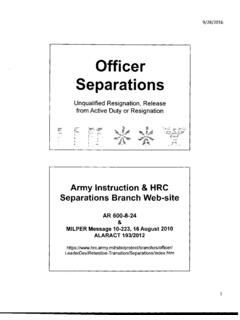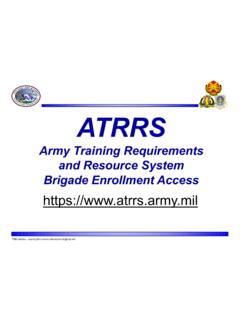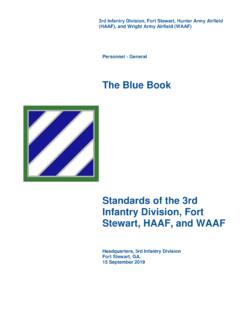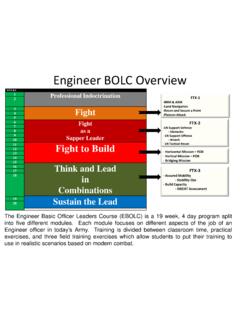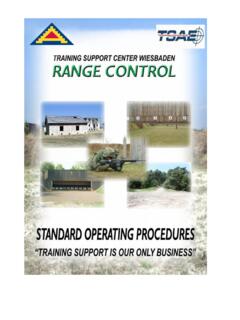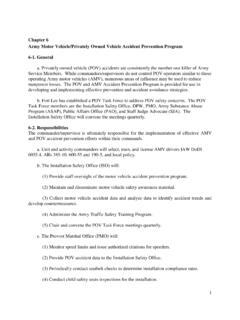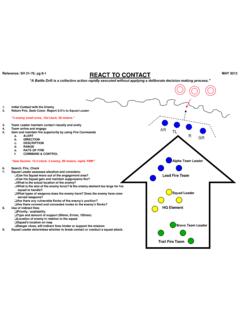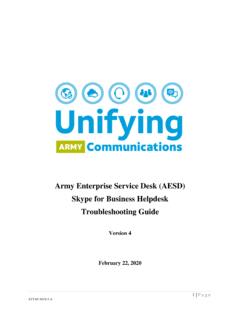Transcription of ACCEPTABLE USE POLICY (AUP)
1 Initial Fort Gordon 29 NOV 18 ACCEPTABLE USE POLICY (AUP) Reference: AR 25-2 (Information Assurance). A well-protected DoD/Army network enables organizations to easily handle the increasing dependence on the Internet. For a DoD/Army organization to be successful, it needs to integrate information that is secure from all aspects of the organization. The purpose of this POLICY is to outline the ACCEPTABLE use of computer equipment within a DoD/Army organization. These rules are in place to protect the employee and the organization. Inappropriate use exposes DoD/Army units to risks including attacks, compromise of network systems and services, and legal issues. This POLICY applies to all employees, contractors, consultants, temporary employees, and other workers assigned to the DoD/Army organizations. I understand that I have the primary responsibility to safeguard the information contained in theSecret Internet Protocol Router Network (SIPRNET) and/or Non-secure Internet Protocol Router Network(NIPRNET) from unauthorized or inadvertent use, modification, disclosure, destruction, and denial or Access to this network is for official use and authorized purposes and as set forth in DOD (Joint Ethics Regulation), AR 25-2 (Information Assurance), and Army network POLICY and Access to Army Information Systems resources is a revocable privilege and is subject to contentmonitoring and security information processing.
2 SIPRNET is the primary classified Information System (IS) for Army is a classified only system and approved to process SECRET collateral information as SECRET and withSECRET handling The SIPRNET provides classified communication to external DoD agencies and other Governmentagencies via electronic mail. SIPRNET is authorized for SECRET level processing in accordance with accredited SIPRNET Approval toOperate (ATO). c. The SIPRNET requires a waiver approval by the 7SC DAA before allowing any user read/write capabilitiesusing CD/DVD. The media must be labeled, secured, and destroyed IAW the procedures for classified medial. classification boundary between SIPRNET and NIPRNET requires vigilance and attention by all The ultimate responsibility for ensuring the protection of information lies with the user. The release of TOPSECRET information through the SIPRNET is a security violation and will be investigated and handled as a security violation or as a criminal offense.
3 F. AR 380-5 is the basic regulation governing the protection of classified material; AR 25-2 governs systemsecurity. Users of classified information are responsible for safeguarding it. Computer systems that are approved and process classified information must be protected in the same manner as classified paper documents. g. Passwords for classified systems, e- mail accounts, and/or networks are classified and must be protected at thehighest classification level of the system. h. Classified systems are approved under strict configuration guidelines. Users are prohibited from making anychanges to system settings, installing software applications or utilities, or modifying/changing system hardware. Fort Gordon 29 NOV 18 Initial 5. Unclassified information processing. The NIPRNET is the primary unclassified information system for Army units. NIPRNET provides unclassified communication to external DoD and other United States Government organizations.
4 Primarily, this is done via electronic mail and Internet networking protocols such as Web Access, Virtual Private Network, and Terminal Server Access Controller System (TSACS). a. NIPRNET is approved to process UNCLASSIFIED, SENSITIVE information in accordance with AR 25-2 and local automated information system security management policies. A Designated Approval Authority (DAA) has accredited this network for processing this type of information. b. The NIPRNET and the Internet, for the purpose of the AUP, are synonymous. E- mail and attachments are vulnerable to interception as they traverse the NIPRNET and Internet, as well as all inbound/outbound data, external threats ( worms, denial of service, hacker) and internal threats. c. Public Key Infrastructure (PKI) Use: (1) Public Key Infrastructure provides a secure computing environment utilizing encryption algorithms (Public/Private-Keys). (2) Token/Smart Card (or CAC). The Cryptographic Common Access Card Logon (CCL) is now the primary access control mechanism for all Army users (with very few exceptions).
5 This is a two phase authentication process. First, the CAC is inserted into a middleware (reader), and then a unique user PIN number provides the validation process. (3) Digital Certificates (Private/Public Key). CAC is used as a means to sending digitally signed e- mail and encrypted e- mail. (4) Private Key(digital signature), as a general rule, should be used whenever e- mail is considered Official Business and contains sensitive information (such as operational requirements). The digital signature provides assurances that the integrity of the message has remained intact in transit, and provides for the non-repudiation of the message that the sender cannot later deny having originated the e- mail. (5) Public Key is used to encrypt information and verify the origin of the sender of an email. Encrypted mail should be the exception, and not the rule. It should only be used to send sensitive information, information protected by the Privacy Act of 1974, and Information protected under the Health Insurance Portability and Accountability Act (HIPAA).
6 (6) Secure Socket Layer (SSL) technology should be used to secure a web based transaction. DoD/Army Private (Intranet) web servers should be protected by using this technology IAW DoD/Army PKI implementation guidance. 6. User Minimum-security rules and requirements. As a SIPRNET and/or NIPRNET system user, the following minimum-security rules and requirements apply: a. I understand personnel are not permitted access to SIPRNET or NIPRNET unless they have met the appropriate DOD and Army personnel security requirements for accessing the system. b. I have completed the required security awareness-training (Annual AT Awareness Training Level I or Computer Security for Users) and provided proof of completion to my IASO. IAW AR 25-2, prior to receiving 2 Initial Fort Gordon 29 NOV 18 network/system access, I will participate in all DoD/Army sponsored Security Awareness Training and Certification programs inclusive of threat identification, physical security, ACCEPTABLE use policies, malicious content and logic identification, and non-standard threats such as social engineering.
7 I understand that my initial training certificate will expire one year from the date that I successfully complete training and that I will be required to complete annual refresher training (IAW AR 25-2). I understand that my account will be disabled if I do not complete the annual certification training by the anniversary date. c. I will protect my logon credentials (passwords or pass-phrases). Passwords will consist of at least 14 characters with 2 each of uppercase and lowercase letters, numbers, and special characters. I am the only authorized user of my account. I will not use my user ID, common names, birthdays, phone numbers, military acronyms, call signs or dictionary words as passwords or pass-phrases. IAW AR 25-2, Chapter 4, Section IV, Para 4-12, passwords should be changed at least every 90 days to 150 days. d. When I use my CAC to logon to the network, I will ensure it is removed and I am logged off prior to leaving the computer.
8 E. I will use only authorized hardware and software on the DoD/Army networks to include wireless technology. I will not install or use any personally owned hardware (including removable drives), software, shareware, or public domain software. f. To protect the systems against viruses or spamming, I will use virus-checking procedures before uploading or accessing information from any system, diskette, attachment, compact disk, thumb storage device, or other storage media. g. I will not attempt to access or process data exceeding the authorized IS classified level. h. I will not alter, change, configure, or use operating systems, programs, or information systems except as specifically authorized. i . I will not introduce executable code (such as, but not limited to, .exe, .com, .vbs, or .bat files) without authorization, nor will I write malicious code. j. I will safeguard and mark with the appropriate classification level all information created, copied, stored, or disseminated from the IS and will not disseminate it to anyone without a specific need to know.
9 K. I will not utilize Army or DOD provided IS for commercial financial gain or illegal activities. l. Maintenance will be performed by the System Administrator (SA) only. m. I will immediately report any suspicious output, files, shortcuts, or system problems to the SA and/or the Information Assurance Support Officer (IASO) and cease all activities on the system. n. I will disable the wireless capability on all devices before connecting to the network, per Best Business Practice: Wireless Security Standards. o. I will address any questions regarding POLICY , responsibilities, and duties to my IASO and/or Network Enterprise Center (NEC) IAM p. I understand that each IS is the property of the Army and is provided to me for official and authorized use. 3 4 Fort Gordon 29 NOV 18 Initial q. I understand that monitoring of SIPRNET and NIPRNET will be conducted for various purposes and information captured during monitoring may be used for possible adverse administrative, disciplinary or criminal actions.
10 I understand that the following activities are prohibited uses of an Army IS: (1) Unethical use ( Spam, profanity, sexual misconduct, gaming, extortion). (2) Accessing and showing unauthorized sites ( pornography, streaming videos, E- Bay, chat rooms). (3) Accessing and showing unauthorized services ( peer-to-peer, distributed computing). (4) Unacceptable use of e-mail include exploiting list servers or similar group broadcast systems for purposes beyond intended scope to widely distribute unsolicited e- mail (SPAM); sending the same e- mail message repeatedly to interfere with recipient s use of e- mail; sending or broadcasting, e- mail messages of quotations, jokes, etc., to multiple addressees; and sending or broadcasting unsubstantiated virus warnings ( mass mailing, hoaxes, auto- forwarding) from sources to anyone other than IAM. (5) Any use that could cause congestion, delay, degradation or disruption of service to any government system or equipment is unacceptable use ( , video, sound or other large files, push technology on the internet and other continuous data streams).
